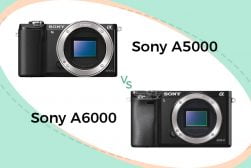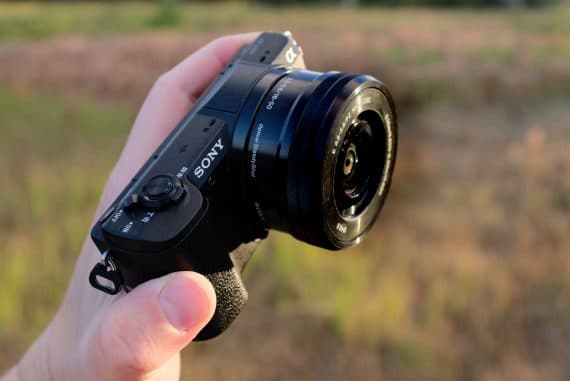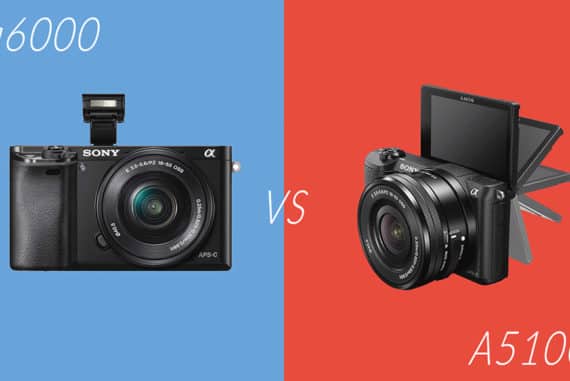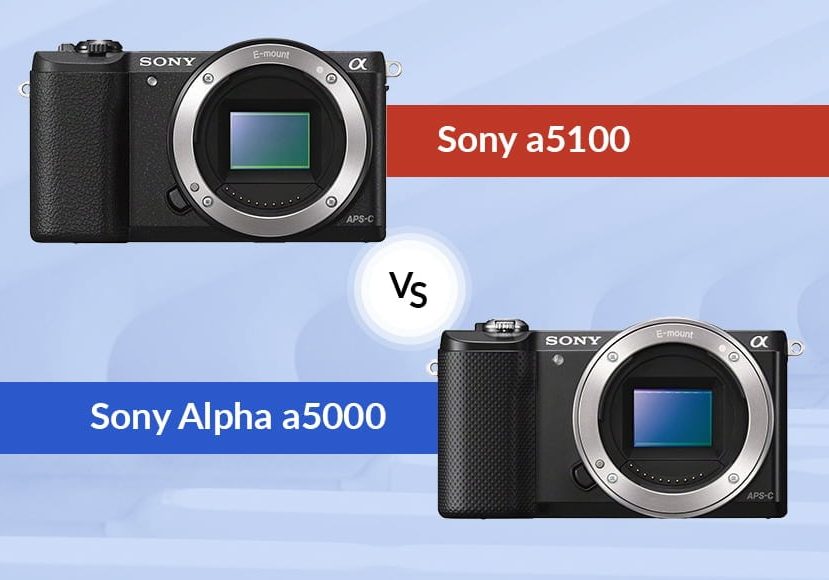
Sony a5000 vs 5100 APS-C Camera Comparison
Choosing between the Sony a5000 vs a5100? This guide covers everything you need to know! Find out the pros and cons of each and which one wins.
The Sony a5000 and Sony a5100 may look and sound similar, but they are actually quite different compact APS-C CMOS sensor cameras.
Both are great entry-level options which open the doors to a range of excellent Sony e-mount lenses and accessories, but it’s important to know how they differ.
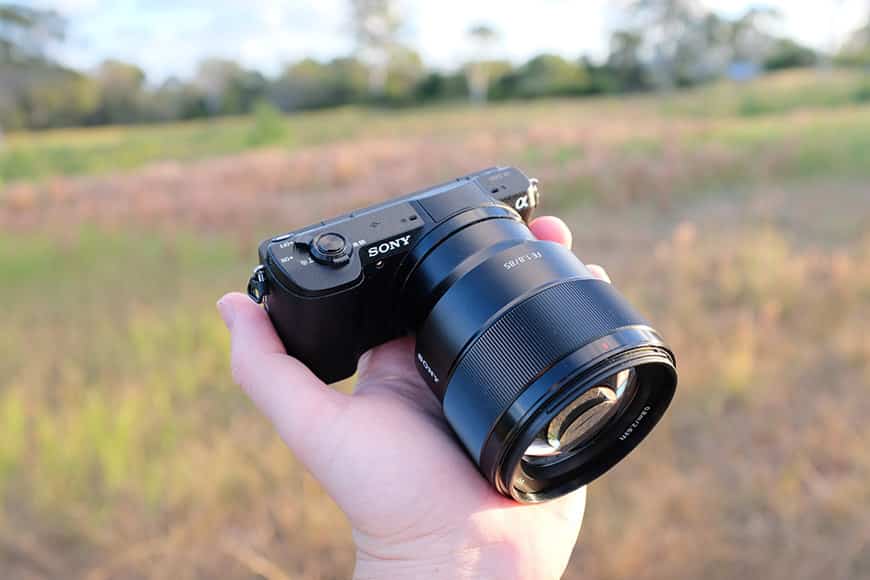
The a5100 outshines the a5000 on performance, autofocus, and a far superior LCD screen.
In this point-by-point comparison, we’ll examine how these two mirrorless Sony mirrorless cameras models square off on key performance metrics and explain which is the better choice for you here in 2024.
Let’s dive right in.
Sony Alpha a5100 vs 5000 | Key Differences
1. Size, Build & Weight
You’ll notice right away that when it comes to size and build, the Sony a5000 and a5100 differ only marginally.
Both cameras look more or less identical to each other and weigh nearly the same. You can see how little difference there is with the respective measurements below:
Sony a5000
- Height: 6.3 cm/2.5″
- Width: 10.1 cm/4.3″
- Depth: 3.6 cm/1.4″
- Weight: 269 grams/0.59 lb
Sony a5100
- Height: 6.3 cm/2.5″
- Width: 10.1 cm/4.3″
- Depth: 3.6 cm/1.4″
- Weight: 283 grams/0.62 lb
As you can see, there’s no difference at all in dimensions and nearly nothing in weight in this part of the Sony a5000 vs a5100 comparison.
Both the Sony a5000 and a5100 also come with the same E-Mount lens mount, and can thus handle the same optics interchangeably.
Even their button controls are virtually identical in both their placement and type. The only difference we can see is that the Sony a5000 comes with a silver on/off switch and joined shutter release button while the a5100 offers them in pure black.
One other thing that needs to be said about both of these Sony cameras is that they’re really small. Size-wise they’re even more compact than the also-petite a6000.
Given that both the Sony a5000 and a5100 come with very conservative hand grips, this might make them a pain to use after a while if you happen to have large hands.
It’s also worth noting that both of these cameras lack an electronic viewfinder, which only emerged with the release of Sony’s a6000 camera edition in 2014. In other words, with either one, you’re stuck composing your shots via the inferior means of an LCD screen, in live view.
Another thing that both the a5000 Sony and a5100 lack is a hot shoe mount.
You might not mind the lack of either of these common mirrorless camera features, but if you’re looking for a more professional shooting build, both the Sony a5000 and a5100 are going to disappoint on built-in peripherals.
On a final note, neither the Sony a5000 nor a5100 have weather-sealed bodies. Sony didn’t introduce this feature until its much later and pricier Alpha series, so be careful if using either on a rainy/snowy day or in some soggy or dusty place.
To sum up, the Sony a5000 and a5100 look and weigh more or less the same – so we’ll have to look at their internals and photo/video performance to find out where these two mirrorless camera models start to really differ.
These are the subjects that we’re going to cover next.
2. Continuous Shooting and Autofocus
Build differences aside, the a5000 and a5100 mirrorless cameras definitely deliver different levels of photographic performance. This becomes noticeable right away when you start playing around with their autofocus and continuous shooting features.
Here, the Sony a5100 outclasses the a5000 by a huge margin. The a5100, which was released several months after the a5000, offers up a 6fps continuous shooting speed that’s at least respectable.
The 3.5fps continuous shooting capability of the a5000, on the other hand, is strictly light-weight and no good for any serious action photography.
Both cameras do however have the same pretty good 1/4000 maximum shutter speed for still life shots.
On autofocus, the a5100 absolutely kicks the a5000’s ass.
Just like Sony’s a6000, it offers up a total of 179 phase-detection AF points across almost 95% of its 24.2-megapixel APS-C sensor, and adds a further 25 contrast-detection points on top of this.
That’s some great continuous AF versatility right there for shooting moving subjects and action more precisely.
The a5000 only comes with a fairly meager 25 contrast-detection-point AF system for its 19.8 MP APS-C sensor. This is good for little more than basic, light action photography, though it won’t really affect still-life shooting.
What makes the AF technology of the a5100 even cooler is that the camera’s LCD display comes with a touch screen AF adjustment setting that lets you move your focus point during photo composition.
This spec doesn’t work during video shooting (as is the case in the Sony a6500) but it’s still excellent as a shooting precision-enhancer on the fly.
3. Image Quality, Sensor and Performance
When it comes to image quality, you can’t ignore the fact that lens choice has a lot to do with it. As noted above, both these cameras are E-Mount, which means they offer the same lens compatibility.
In terms of raw resolution, however, the a5100 delivers the obviously-better specs than the Sony a5000 series due to its much larger 24.2-megapixel APS-C sensor.
This means better light capture, better cropping flexibility and the ability to print out much larger photos for expositions or framing.
With a 24.2-megapixel sensor, photos attain high quality even when scaled up to 30 by 20 inches.
The a5100 also comes with on-sensor phase detection pixels, as we already mentioned above for its AF performance. This makes a huge difference for sharper images due to better autofocus acquisition.
When it comes to low light performance, the a5100 (literally) shines brighter with its broader ISO range of 100-25,600, for increased low light sensitivity.
You’ll never need to use the upper range of this, but it being high does then improve effective ISO range for low-noise photography in low light.
ISO 100 provides a good base for photography in bright sunlight, and may help when shooting with a fast-aperture lens.
As for the a5000, its native APS-C sensor resolution is only 19.8 megapixels, and though Sony claims they both come with the same essential image processing technology, we suspect that the successor camera does things better.
In any case, the older of the two models can’t quite reach the same object tracking sharpness during continuous shooting because it only comes with 25 contrast-detection points on the CMOS sensor and offers only 3.5fps shooting speed.

© Matt Murray
On a more positive note for the a5000, its 19.8-megapixel resolution is still enough for some great, superbly sharp photos that can be printed out and blown up massively.
Furthermore, in terms of color, contrast and visible photo quality rendering for non-complicated shots (good lighting, not too much movement) the two cameras seem to output photos that are pretty much equal as far as we can tell.
In that sense, the higher resolution of the Sony alpha a5100 doesn’t make a substantial difference.
You’d have to magnify very far into the details of a given photo to note the smaller sensor resolution of the a5000’s results.
You’ll also probably be happy to know that both of these budget alpha cameras come with zebra technology for exposure clipping and other similarly “advanced” features like focus peaking and focus magnification.
As for dynamic range (i.e. the difference between light and dark in any image), both cameras are neck and neck, since they both share the same 24MP APS-C CMOS sensor.
Dynamic range is hindered by the smaller sensor size (APS-C), but there’s still enough data when shooting between ISO 100 – 800 to push and pull your shadows and highlights in post.
Finally, in terms of battery life during sustained shooting, the a5000 outperforms the a5100 by a slight margin.
It can record up to 420 shots at a time before it dies. The newer camera can only manage battery life for about 400, which is itself still pretty good by mirrorless camera standards, and more so if you consider that it’s processing and saving 20% more image resolution per shot.
4. Rear LCD & EVF
Since neither the Sony alpha a5100 or a5000 come with electronic viewfinder technology, there’s not much to say about their EVF qualities. We just think it’s a shame they didn’t get an EVF.
What they do both come with are 3″ LCD displays for live image preview. However, the performance of these screens differs enormously between the older camera vs Sony a5100 LCD quality:
The a5000 comes with a 461k dots screen resolution on its LCD display and, to put it bluntly, this is just crappy. Even when the camera was first released, this 61k dots was a low resolution; now it’s almost unforgivable, with most competitors offering a higher resolution screen.
At 460K dots, visuals simply don’t get quite sharp enough to really appreciate how well or poorly a photo is being composed, and the lack of an OLED EVF with slight zoom only complicates the issue.
Furthermore, the alpha a5000’s images lack a lot of contrast, and obviously enough, they’re on the grainy side. Gauging focus with these conditions is almost guesswork.
Another flaw of this already-bad LCD display in the a5000 is that it also offers weak viewing angles and is way too dim to let you clearly see what you’re doing while shooting in bright ambient light (and especially in sunlight).
All of the display problems of the a5000’s LCD screen apply for video recording too, so it doesn’t really do you any favors on this front either.
The LCD display of the Sony alpha a5100 is much better on every count except its size. For starters, it offers a much improved 921,000-dot resolution that you can actually work with at making sure your focus isn’t off during a live composition.
Secondly, it comes with better brightness and better contrast delivery as far as we could tell.
On a much more exciting note, the a5100’s display also has the excellent benefit of its AF touch screen tech, which allows you to change your focus point with your finger while composing an image (or sequence of images).
This definitely makes shooting a bit easier to handle and we wish more of Sony’s more affordable cameras came with the same technology.
5. Video Recording Specs
In this a5000 vs Sony a5100 comparison, we can safely say that, while both shoot video in 1080p full HD resolution (1920 x 1080), the latter of the two cameras delivers a notably better result almost across the board.
For starters, while the Sony alpha a5000 only manages to record 1080p at 1080/60i, the alpha a5100 delivers much better frame rate power with 1080p video at 60p.
This basically means a higher fps speed for moving images since the 60i of the a5000 translates to only 24 fps for 1920 x 1080 video.
Secondly, the overall quality of the latter camera’s video is just better.
You see, the a5100 was given Sony’s new XAVC S format for its videos and this means a higher bitrate of 50Mbps instead of the 24Mbps that the a5000 manages for MP4 videos.
The higher quality of the a5100’s footage is also reflected in better, easier post-production editing for shoots.
What we should note as a cool feature for both the Sony alpha a5000 and a5100 is that they offer dual video recording, meaning that while either one is shooting its best level of 1080p footage, it also creates a lower-resolution video that you can share quickly to social media sites with quicker upload time.
For Youtube, Facebook, Instagram or Twitter video sharing fans, this is a useful trick.
One thing we don’t like about both of these cameras, though, is that they seem to easily overheat when recording for a while at max resolution in a warm environment.
This little problem won’t make them fail as far as we know, but it’s a bit worrisome for prolonged video recording sessions.
Another thing to note – neither model offers in-body image stabilization, meaning that you’ll need to choose from the selection of APS-C Sony e-mount lenses with IS.
6. Controls and Peripherals
The physical controls that are built into both the alpha a5000 and a5100 offer essentially identical layout and functionality.
They have the same changeable custom key buttons with the same customization options in the same locations; both cameras offer the same position for the same size of shutter release button and power switch, and they both have the same zoom rocker dials.
Their hand grips are also equally small but usable.
In terms of peripherals, the Sony alpha a5000 and alpha a5100 are the same too, as we already covered.
Both cameras lack a hot shoe and EVF, and both lack the mode setting wheel that the a6000 finally came with for quick switching between manual, automatic and other shooting options.
On the other hand, they both do include a pop-up flash, which is handy for certain types of shooting.
Moving on to their internal digital menu and control options, these are the same except for the already-mentioned touch screen for autofocus on the alpha a5100.
Finally, in terms of connectivity, the a5000 and a5100 are both charged via micro USB cables and come with NFC and WiFi connectivity options in case you’d like to share photos online or use an external app for shutter handling.
Neither of these two cameras offers Bluetooth, however.
7. Value for Money
Neither the Sony a5000 nor the a5100 are what we’d consider semi-pro or professional mirrorless cameras. Instead, they’re both closer to starter models.
That’s okay though; they certainly don’t pretend to be anything else, and their prices reflect this.
With that said, the a5100 costs a little bit more than its predecessor by about 18% depending on who you buy it from.
Despite a slightly higher price tag, we absolutely think that the newer of these two models offers much better value for money.
The a5000 is okay for basic photography in terms of raw performance but its AF point specs are dismal, and the LCD display is almost catastrophically bad. Because it lacks an EVF, this is a huge weakness.
The higher resolution, better LCD screen, and much greater number of phase and contrast AF points in the a5100 absolutely justify paying a bit more for it.
Final Thoughts
After comparing these two compact Sony mirrorless cameras across their key performance specs and prices, we have to say that the Sony a5100 is without a doubt the better choice in just about every measurable way.
Though both cameras look and feel virtually identical and offer the same Sony APS-C lens options, the Sony a5100 offers much better value for its price, superior performance, and better features.
On the other hand, you might want to just skip either of these cameras and simply hop over to the even better Sony Alpha a6000, which is also very affordable for the excellent performance it offers.

The a5100 outshines the a5000 on performance, autofocus, and a far superior LCD screen.





